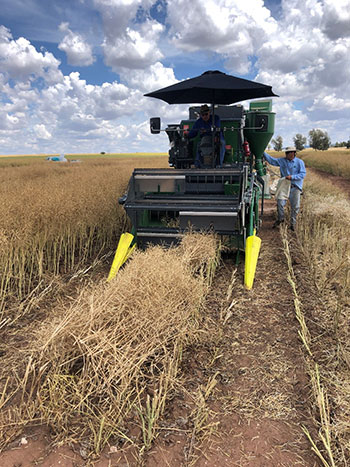A new research effort is looking to identify the key seed characteristics that improve open-pollinated (OP) canola establishment and, in parallel, develop in-crop strategies to promote these characteristics in grower retained OP seed.
OP canola varieties are grown on a significant area of the low to medium-rainfall zone across Australia. Commonly, growers produce these OP canola crops from retained seed, but there is a risk that vigour may decrease over time, affecting germination and establishment.
This is being addressed by a GRDC-supported team led by the NSW Department of Primary Industries, including AgGrow Agronomy and Research and the Grain Orana Alliance.
As canola seed is small, it has less energy reserves than larger-seeded crops and, as a result, is more sensitive to poor establishment across a range of seasonal conditions and agronomic management strategies.
For growers looking to reduce the cost of crop inputs, canola establishment has become an emerging issue over the past decade due to increased seed costs, reduced seeding rates, unreliable autumn rainfall and sowing into marginal seedbed conditions.
Currently, grower-retained canola seed is managed the same as a typical commercial paddock, except the largest seed is screened and retained. The sieve size used is normally determined by the ratio of total seed graded to how much seed is required for the following sowing.
There is little to no understanding about the role of seed composition (oil percentage, protein percentage, starch, seed weight, seed nutrient content and fatty acid profile) to improve seed vigour and establishment.
Areas of investigation include crop and seed nutrition, canopy architecture and harvest management, with the following research questions in mind:
- What is the optimum nutrient strategy to produce high-vigour seed lots?
- Does foliar nutrition allow an opportunity to load up the seed with various nutrients to improve seed vigour/establishment?
- What type of canopy architecture produces larger seed?
- How important is spatial arrangement?
- Does reducing total bud number increase the carbohydrate supply to the remaining buds?
- How will harvest management affect next year’s seed vigour?
- Is there any difference between the various desiccation method/products and timings?
Field intelligence
Seed crop experiments were sown in 2020 across four growing regions (central-eastern New South Wales, central-western NSW, south-eastern NSW and south-western NSW), and included a range of nutrient, canopy and harvest management experiments. The seed harvested from these experiments was graded to various seed sizes and evaluated via seed vigour testing (growth, stress and biochemical testing) and field establishment trials were run in 2021.
Preliminary findings show that field establishment ranged from 23 to 72 per cent, and was affected by seed size, seed crop agronomy and growing environment.
 Example of seed-crop harvest management trials at Tottenham, NSW. Photo: NSW DPI
Example of seed-crop harvest management trials at Tottenham, NSW. Photo: NSW DPI
Averaged across all sites, field establishment increased by six percentage points as seed size increased from 1.6 to 2 millimetres diameter; five percentage points with additional phosphorus; four percentage points if the seed lot was largely derived from the main stem as opposed to the lateral branches (that is, high seeding rate); and four percentage points if grown in the regions with a cooler/softer environment.
Early indications are that gains to field establishment via seed crop agronomy are likely through a series of small incremental gains rather than one specific management operation.
However, growers must be aware that harvest management can reduce a high-vigour seed lot to a low-vigour seed lot if the seed crop is desiccated too early and/or glyphosate has been used as a harvest aid/weed control.
Preliminary tips for growing open-pollinated canola seed (research is ongoing)
- Select large-sized seed (grade as big as possible).
- Ensure seed crop had adequate phosphorus.
- Ensure seed crop was largely derived from main stem (that is, high plant density, approximately 40 plants per square metre or higher).
- Source seed from regions of cooler/softer environments (east compared to west).
- Ensure seed crop was direct-harvested or windrowed late. Avoid seed crops that have had glyphosate applied as harvest aid/weed control.
More information: Colin McMaster, 0427 940 847, colin.mcmaster@dpi.nsw.gov.au

























































